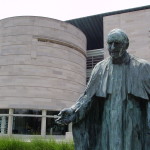The Bruges Madonna from The Michelangelo Tour is currently on loan to the Pope John Paul II Cultural Center in Washington DC.
 The Pope John Paul II Cultural Center is a Roman Catholic museum and think tank in Washington, D.C. The concept for the center began at a meeting between Pope John Paul II and then-Bishop Adam Maida in 1988. The 100,000-square-foot (9,300 m2) building is set on 12 acres (4.9 ha) adjacent to the Catholic University of America and the Basilica of the National Shrine of the Immaculate Conception. The center was opened to the public in a ceremony in March 2001, attended by President George W. Bush, several cardinals, members of Congress and other dignitaries.
The Pope John Paul II Cultural Center is a Roman Catholic museum and think tank in Washington, D.C. The concept for the center began at a meeting between Pope John Paul II and then-Bishop Adam Maida in 1988. The 100,000-square-foot (9,300 m2) building is set on 12 acres (4.9 ha) adjacent to the Catholic University of America and the Basilica of the National Shrine of the Immaculate Conception. The center was opened to the public in a ceremony in March 2001, attended by President George W. Bush, several cardinals, members of Congress and other dignitaries.
The Center’s original purpose was to explore the intersection of faith and culture through interactive displays, academic discussion and research, and museum exhibits. It has gone through several periods of difficulty and layoffs, with the most recent in May 2006 seeing the dismissal of almost 90% of its staff, and in June 2006, the replacement of its second executive director in less than two years. The Cultural Center is now in a period of reorganization, abandoning its art museum and emphasizing its original goal of exploring faith and culture in an academic context.
For reservations and information about viewing Michelangelo’s Burges Madonna while in Washington DC:
Pope John Paul II Cultural Center
3900 Harewood Rd NE
Washington, DC 20017-1505
(202) 635-5400
www.jp2cc.org
About the The Bruges Madonna and Child:
Early in 1504, even as the David received its finishing touches, Michelangelo was already at work on a free-standing marble statue of the Madonna and Child. The Bruges Madonna, as it is known today, thus followed Michelangelo’s Pieta in St. Peter’s by only five years. In both of these important sculptures, the Virgin Mary’s face is noticeably young and beautiful. The two works of art underscore different qualities, however.In the Pieta, Mary appears as a delicate maiden; in the Bruges Madonna, she is portrayed with the dignity of the Queen of Heaven. Umberto Baldini, a noted historian of the Italian Renaissance, wrote, “In this work we see Michelangelo engaged in the search for an almost architectonic solemnity, which instills a new moral and physical content.”
Read more and see additional images of the Burges Madonna and Child.
